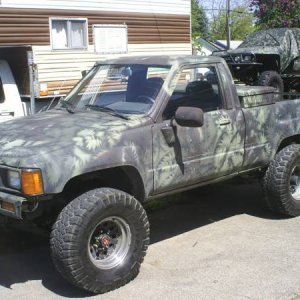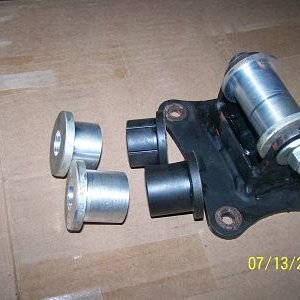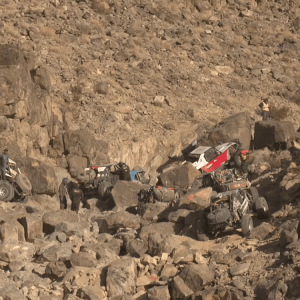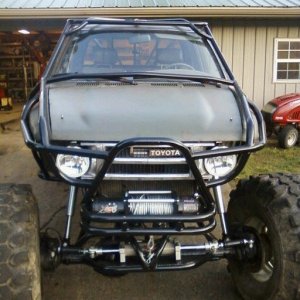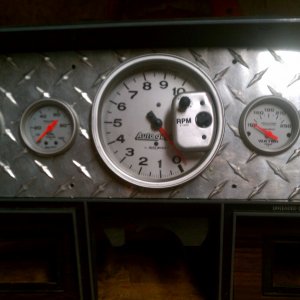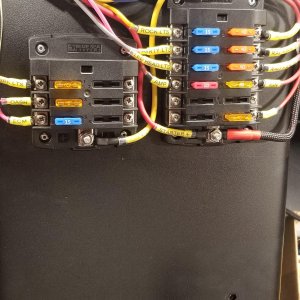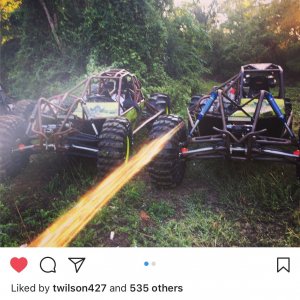-
Help Support Hardline Crawlers :
You are using an out of date browser. It may not display this or other websites correctly.
You should upgrade or use an alternative browser.
You should upgrade or use an alternative browser.
Ground pressure poll
- Thread starter Skid Mark
- Start date
benw1
Well-Known Member
I'm not sure exactly what "ground pressure" means. Not because I don't understand the forces involved, but because it's not a real term. My interpretation of Skid Mark's original post seems to indicate that it's the weight of the vehicle (at each tire) divided by the contact patch area. My assertion is that you could save yourself a lot of drawing, measuring, weighing, and calculating by just using a tire pressure gauge.
Ground Pressure is not a real term? Someone better tell CAT, they list ground pressure specs on lots of their equipment, I think they'd want to know its not a real term.
http://www.cat.com/cda/components/fullArticle?m=38580&x=7&id=1012259
http://en.wikipedia.org/wiki/Ground_pressure
:haha:
benw1
Well-Known Member
Minnesota DNR says that using low ground pressure equipment is a best practice for Forest Management. Too bad its not a real term.
http://www.extension.umn.edu/distribution/naturalresources/dd7015.html
http://www.extension.umn.edu/distribution/naturalresources/dd7015.html
Ty.
Well-Known Member
Dang ChopShop, I tried, but I couldn't beat that one. That was funny:haha:
CHOP SHOP
Well-Known Member
Dang ChopShop, I tried, but I couldn't beat that one. That was funny:haha:
Its gets tiresome when the Pressure is on!!:haha::haha:
boardbysled
Tree Nerd.
This is a legitimate question, but there are so many variables, that it is just way to hard to collect the data. With machinary, you generally have specific sized tracks or tires designed for a machine, so it is easy to measure. We are going against what our machines are designed for:;
Skid Mark
Well-Known Member
Whats the footprint on a tire like this make for ground pressure?
If there old-school Reebok pumps I bet you can lower the pressure and get a wider foot print
Ground Pressure is not a real term? Someone better tell CAT, they list ground pressure specs on lots of their equipment, I think they'd want to know its not a real term.
http://www.cat.com/cda/components/fullArticle?m=38580&x=7&id=1012259
http://en.wikipedia.org/wiki/Ground_pressure
:haha:
Thank you
And to reference the tire psi issue 64fj40 was having A tire is round with equal sides on in it doesn't matter what air pressure your at the pressure is pushing on ALL sides evenly thus has NO direct effect on ground pressure other then changing the size of the foot print of the said tire.
Ty.
Well-Known Member
:signhijacked:
I feel the pressure. You're on a roll. I can't get any traction. I must be tired.
Its gets tiresome when the Pressure is on!!:haha::haha:
I feel the pressure. You're on a roll. I can't get any traction. I must be tired.
This is a legitimate question, but there are so many variables, that it is just way to hard to collect the data. With machinary, you generally have specific sized tracks or tires designed for a machine, so it is easy to measure. We are going against what our machines are designed for:;
No variables at all, in soft ground like we have in the PNW the WHOLE tire foot print is carrying weight, everyone is over thinking this question, just figure out what your footprint is on each tire, then divide it by the weight, simple math guys.
And if ground pressure didn't matter nobody would air down in the snow :;
boardbysled
Tree Nerd.
No variables at all, in soft ground like we have in the PNW the WHOLE tire foot print is carrying weight, everyone is over thinking this question, just figure out what your footprint is on each tire, then divide it by the weight, simple math guys.
And if ground pressure didn't matter nobody would air down in the snow :;
Makes sense, I was deffinetly over thinking it.:awesomework:
64FJ40
Well-Known Member
Ground Pressure is not a real term? Someone better tell CAT, they list ground pressure specs on lots of their equipment, I think they'd want to know its not a real term.
Fair enough; I stand corrected. I'm not sure why they (or the MN DNR) use that term, but most engineers call it "contact pressure", which is considerably more proper in my opinion.
And to reference the tire psi issue 64fj40 was having A tire is round with equal sides on in it doesn't matter what air pressure your at the pressure is pushing on ALL sides evenly thus has NO direct effect on ground pressure other then changing the size of the foot print of the said tire.
Holy cow. Do you really believe this? Why do you think the footprint changes size with different internal air pressures?
Skid Mark
Well-Known Member
Holy cow. Do you really believe this? Why do you think the footprint changes size with different internal air pressures?
You are so smart your out smarting your self. This is classic.. Please some one talk to this yuppie and explain to him his own ignorance.
Err wait I'm not done.
LMFAORQD AGAIN YOU have been officially owned for life your flat cut off OUT FAWKING STANDING you are so self involved you obviously have some disapproval of me and it bleeds through your words with the sounds of "I got more bank roll then brain roll"
And if you haven't got it by now its a lost cause
Last edited:
64FJ40
Well-Known Member
816 inches of contact with my 33/12.5 @12 psi. My jeep prepared to go is about 5500lbs so ON AVERAGE I have a 6.74 gppsi
I'm going to make this as simple as possible without breaking out my crayons and drawing you a picture. If anybody else following along disagrees with me or doesn't understand, feel free to explain why and I'll try to address those with more specific examples.
It is not possible to have a 6.74psi contact pressure when your tires are inflated to 12psi unless you're sitting on a surface that can only support 6.74psi. With 1375 pounds on a tire at 12psi, the contact patch area is 114.6 square inches when on surface capable of supporting weight at 12psi or greater. The air pressure inside the tire is what supports that weight of 1375 pounds, and it does that by exerting a force against the ground. If the ground is unable to support weight at 12psi, you sink until you have enough contact patch to support the weight being placed on that tire. Just for illustration, pretend some sand area can support 8psi. Your tires will sink in a little bit. This increases your contact patch area until the area reaches 172 square inches.
Think of it like a latex balloon. Pretend that inflated balloon has 1psi of internal air pressure. If you push the balloon against the wall with 5 pounds of force, it the contact area will be 5 square inches (that's why it's called pounds per square inch). Now push with 10 pounds of force. The contact pressure is still only 1 psi, but that pressure is spread out over 10 square inches. The contact patch just keeps getting bigger (until you reach the elastic capacity of the balloon) in order to support more weight.
Why do you think the footprint changes size with different internal air pressures?
Exactly, as the footprint gets bigger your ground pressure is decreased
BTW..You are being way too technical for this crowd, this is a 4x4 forum, not an MIT discussion board, opposite ends of the spectrum :redneck:
Skid Mark
Well-Known Member
I'm going to make this as simple as possible without breaking out my crayons and drawing you a picture. If anybody else following along disagrees with me or doesn't understand, feel free to explain why and I'll try to address those with more specific examples.
It is not possible to have a 6.74psi contact pressure when your tires are inflated to 12psi unless you're sitting on a surface that can only support 6.74psi. With 1375 pounds on a tire at 12psi, the contact patch area is 114.6 square inches when on surface capable of supporting weight at 12psi or greater. The air pressure inside the tire is what supports that weight of 1375 pounds, and it does that by exerting a force against the ground. If the ground is unable to support weight at 12psi, you sink until you have enough contact patch to support the weight being placed on that tire. Just for illustration, pretend some sand area can support 8psi. Your tires will sink in a little bit. This increases your contact patch area until the area reaches 172 square inches.
Think of it like a latex balloon. Pretend that inflated balloon has 1psi of internal air pressure. If you push the balloon against the wall with 5 pounds of force, it the contact area will be 5 square inches (that's why it's called pounds per square inch). Now push with 10 pounds of force. The contact pressure is still only 1 psi, but that pressure is spread out over 10 square inches. The contact patch just keeps getting bigger (until you reach the elastic capacity of the balloon) in order to support more weight.
First you are trying to create one equasion with two problems YOUR TIRE PSI HAS NO EFFECT ON GROUND PRESSURE OTHER THEN CONTROLLING THE SIZE OF YOUR FOOT PRINT. Maybe you should go write on the NHRA website and tell them tire psi has no effect on your tire foot print I'm pretty shure they would want to know they been doing it wrong since they started.
Let me explain..
your tire is round
The psi in the tire is pushing on ALL sides of the tire
The top of the tire has the same pressure inside as the bottom.
that cancels out the first number in your equation
10 pounds of pressure pushing down and UP
The tire it self is the only thing holding the weight
the tire pressure is what gives the rubber tire its ridgidity to support the weight
the weight goes from the axle to the rim to the tire and the ground
Not axle rim AIR tire ground
You are wrong sir and you don't want some poor person that has less education then you making you look stupid I understand that.
Last edited:
Skid Mark
Well-Known Member
EPIC FAIL
:haha::haha:
A person who agrees with another for only to write negative comments about something he has no understanding
You are the failure
Skid Mark
Well-Known Member
Exactly, as the footprint gets bigger your ground pressure is decreased
BTW..You are being way too technical for this crowd, this is a 4x4 forum, not an MIT discussion board, opposite ends of the spectrum :redneck:
The best part is mr make it complacated is wrong and that will come to light.. again
Skid Mark
Well-Known Member
Your statement is incorrect. The tire pressure (air pressure inside the tire) may not be 40 psi. It could even be ZERO psi for that matter. Your statement does not account for the tire construction. For example, take the same 5,000 lb. truck and fit semi tractor tires to it, with an 8,000lb load rating per tire. You could run zero psi in those tires and support the weight of the truck with almost no deformation of the carcass.
Consider Newtons third law. In the case of the tire, the opposite reaction is a combination of tire pressure AND carcass construction.
I did some research to prove my point and wow I found a forum with a similar discussion. I thought if you read it some were else you might respect it. I stoled this from IH8MUD.com but you can go argue with theirs guys they have more smearts then this redneck :fawkdancesmiley:
Boonie Buster
Stuck on a Curb
It's like walking on 4' of soft snow in tennis shoes, you will sink through, but if you have snow shoes on to displace your weight, you wont fall through. By airing down you're essentially lowering your "ground pressure", but at the same time you're increasing your contact patch and increasing traction (in theory)
So to sum up this thread, less ground pressure equals better traction. :awesomework:
BTW, Skids, I'm not sure you even know what this thread is about. :haha:
So to sum up this thread, less ground pressure equals better traction. :awesomework:
BTW, Skids, I'm not sure you even know what this thread is about. :haha:



